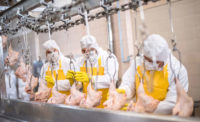Allergen Detection Requires a Multipronged Approach

In the United States, up to seven million people have a food allergy, and about two million of them are children. Allergies account for about 30,000 emergency room visits per year, and food allergen alerts accounted for nearly 30 percent of all food recalls and notifications in 2016, according to the U.S. Department of Agriculture Food Safety and Inspection Service. Therefore, food processors have been struggling to be able to identify and eliminate the allergens most likely to cause these reactions.
The “gold standard” method for allergen detection is the enzyme-linked immunosorbent assay (ELISA). ELISA works by using specific antibodies associated with a suspected allergen to generate a precise, proportional signal to the allergen level. While ELISA can detect very small amounts of allergen, ELISA tests are specific for only that allergen. In addition, ELISA testing can take several hours and requires sophisticated laboratory training and experience.
Three other technologies can also assess allergen risk. These other technologies do not detect levels of allergens as low as ELISA, but three Hygiena techniques can quickly detect the presence of any protein or use proxy molecules like adenosine triphosphate (ATP) to determine the existence of allergen-containing residues on a surface.
ATP Sanitation Monitoring
Detection of ATP, the energy-delivering molecule of living cells, is a measure of the presence of any protein or organic matter, but it cannot differentiate between allergens or between nonallergenic organic materials. Sensitive systems, like the SuperSnap™ High-Sensitivity Surface ATP Test with the EnSURE™ Monitoring System, use ATP as a proxy measure of proteins at levels that could indicate the presence of allergens.
The Biuret Test (Piotrowski’s Test)
Biuret is a method in which a reagent turns from green to violet when it comes into contact with certain amino acids (a certain sign of protein presence). Tests based on this method, like the AllerSnap™ High-Sensitivity Allergen Prevention test, cannot distinguish between proteins but can provide a “yes-no” colorimetric answer to determine whether a potential allergen-containing residue is present.
Lateral Flow
These “dipstick”-like devices are convenient and fast, and indicate the existence of certain allergens by a color change. Tests need to be specific, like Hygiena’s AllerFlow Gluten (which determines the presence of gluten or gliadin proteins), and are more affordable, quicker, and more convenient than ELISA tests.
Comparative Results for Allergen Detection
Hygiena researchers recently showed that, while not approaching the level of detection of ELISAs, general protein and enhanced sensitivity ATP systems can determine the possible presence of allergens at levels low enough for the investigation of specific proteins.
Researchers compared a range of ELISA tests for allergens against the EnSURE Monitoring System with the SuperSnap ATP test devices and the AllerSnap Allergen Prevention Test. Eleven major allergens were tested in a variety of foods to determine the minimal levels needed for detection. Of the allergens tested, almonds were detectable at lower or equal levels than ELISA testing by SuperSnap and AllerSnap.
For most allergens, it is not certain what levels can begin causing health issues in sensitive people. Currently, gluten/gliadin is the only allergen that has a regulated level—20 ppm—below which the product is considered “gluten-free.” Therefore, even a nonspecific reading that indicates possible protein presence can be a valuable piece of information in the overall allergen-prevention program.
No matter what technique is used, allergen control and prevention must be part of an overall management program: a plant design that allows easy cleaning and sanitizing with no locations that allow the accumulation of debris, validated cleaning verification procedures, and plans regarding storage, handling, processing, packaging and identification of allergenic foods and ingredients. Any control plan must be audited, enforced and updated continually, and management and staff need to verify their education on these procedures and compliance with the overall plan.
Effective allergen control and prevention will require more than one test. The elusive nature, small quantities and complex sources of allergens require a sophisticated approach, consisting of a number of different techniques that can detect both specific and nonspecific contaminants from product residues. Examples of cost-effective systems include high-sensitivity ATP measurement, high-sensitivity nonspecific protein detection and specific allergens tests in convenient lateral flow strip formats.
A robust allergen detection and prevention plan, in turn, must be part of a comprehensive food safety management structure, which includes methods to identify evidence of incomplete cleaning, signs of potential bacterial pathogens and identification of indicator organisms and pathogens. Like any other health and safety strategy, allergen detection that’s based on prevention is better than a cure, saving time, money and lives.
www.hygiena.com
Looking for a reprint of this article?
From high-res PDFs to custom plaques, order your copy today!








